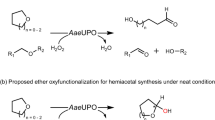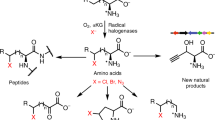Abstract
Polycyclic bio-active natural products that contain halogen atoms have been isolated from a number of different marine organisms1. The biosynthesis of these natural products appears to be initiated by an electrophilic halogenation reaction at a carbon–carbon double bond2,3,4 via a mechanism that is similar to a proton-induced olefin polycyclization5,6,7,8. Enzymes such as haloperoxidases generate an electrophilic halonium ion (or its equivalent), which reacts with the terminal carbon–carbon double bond of the polyprenoid, enantioselectively inducing a cyclization reaction that produces a halogenated polycyclic terpenoid. Use of an enantioselective halocyclization reaction is one possible way to chemically synthesize these halogenated cyclic terpenoids; although several brominated cyclic terpenoids have been synthesized via a diastereoselective halocyclization reaction that uses stoichiometric quantities of a brominating reagent9,10,11,12, the enantioselective halocyclization of isoprenoids induced by a chiral promoter has not yet been reported. Here we report the enantioselective halocyclization of simple polyprenoids using a nucleophilic promoter. Achiral nucleophilic phosphorus compounds are able to promote the diastereoselective halocyclization reaction to give a halogenated cyclic product in excellent yields. Moreover, chiral phosphoramidites promote the enantioselective halocyclization of simple polyprenoids with N-iodosuccinimide to give iodinated cyclic products in up to 99% enantiomeric excess and diastereomeric excess. To the best of our knowledge, this is the first successful example of the enantioselective halopolycyclization of polyprenoids.
This is a preview of subscription content, access via your institution
Access options
Subscribe to this journal
Receive 51 print issues and online access
$199.00 per year
only $3.90 per issue
Buy this article
- Purchase on Springer Link
- Instant access to full article PDF
Prices may be subject to local taxes which are calculated during checkout


Similar content being viewed by others
References
Blunt, J. W., Copp, B. R., Munro, M. H. G., Northcote, P. T. & Prinsep, M. R. Marine natural products. Nat. Prod. Rep. 23, 26–78 (2006)
Yarnell, A. Nature’s X-factors. Chem. Eng. News 84, 12–18 (2006)
Butler, A. & Carter-Franklin, J. N. The role of vanadium bromoperoxidase in the biosynthesis of halogenated marine natural products. Nat. Prod. Rep. 21, 180–188 (2004)
Yamamura, S. & Terada, Y. Isoaplysin-20, a natural bromine-containing diterpene, from Aplysia kurodai.. Tetrahedr. Lett. 18, 2171–2172 (1977)
Ishibashi, H., Ishihara, K. & Yamamoto, H. A new artificial cyclase for polyprenoids: enantioselective total synthesis of (–)-chromazonarol, (+)-8-epi-puupehedione, and (–)-11’-deoxytaondiol methyl ether. J. Am. Chem. Soc. 126, 11122–11123 (2004)
Yoder, R. A. & Johnston, J. N. A case study in biomimetic total synthesis: polyolefin carbocyclizations to terpenes and steroids. Chem. Rev. 105, 4730–4756 (2005)
Johnson, W. S. Biomimetic polyene cyclizations: a review. Bioorg. Chem. 5, 51–98 (1976)
Huang, A. X., Xiong, Z. & Corey, E. J. An exceptionally short and simple enantioselective total synthesis of pentacyclic triterpenes of the β-amyrin family. J. Am. Chem. Soc. 121, 9999–10003 (1999)
Wolinsky, L. E. & Faulkner, D. J. A biomimetic approach to the synthesis of Laurencia metabolites. Synthesis of 10-bromo-α-chamibrene. J. Org. Chem. 41, 597–600 (1976)
González, A. G., Martin, J. D., Pérez, C. & Ramirez, M. A. Bromonium ion-induced cyclization of methyl farnesate: application to the synthesis of snyderol. Tetrahedr. Lett. 17, 137–138 (1976)
Yamaguchi, Y., Uyehara, T. & Kato, T. Biogenetic type synthesis of (±)-concinndiol and (±)-aplysin 20. Tetrahedr. Lett. 26, 343–346 (1985)
Carter-Franklin, J. N., Parrish, J. D., Tschirret-Guth, R. A., Little, R. D. & Butler, A. Vanadium haloperoxidase-catalyzed bromination and cyclization of terpenes. J. Am. Chem. Soc. 125, 3688–3689 (2003)
Kang, S. H., Lee, S. B. & Park, C. M. Catalytic enantioselective iodocyclization of γ-hydroxy-cis-alkenes. J. Am. Chem. Soc. 125, 15748–15749 (2003)
Zhang, Y., Shibatomi, K. & Yamamoto, H. Lewis-acid mediated selective chlorinations of silyl enolate. J. Am. Chem. Soc. 126, 15038–15039 (2004)
Grossman, R. B. & Trupp, R. J. The first reagent-controlled asymmetric halolactonizations. Dihydroquinidine-halogen complexes as chiral sources of positive halogen ion. Can. J. Chem. 76, 1233–1237 (1998)
Cui, X.-L. & Brown, R. S. Mechanistic evaluation of the halocyclization of 4-penten-1-ol by some bis(2-substituted pyridine) and bis(2,6-disubstituted pyridine)bromonium triflates. J. Org. Chem. 65, 5653–5658 (2000)
Haas, J., Piguel, S. & Wirth, T. Reagent-controlled stereoselective iodolactonizations. Org. Lett. 4, 297–300 (2002)
Fukuzumi, T., Shibata, N., Sugiura, M., Nakamura, S. & Toru, T. Enantioselective fluorination mediated by cinchona alkaloids/selectfluor combinations: a catalytic approach. J. Fluor. Chem. 127, 548–551 (2006)
Acknowledgements
Financial support for this project was provided by the JSPS (KAKENHI), the 21st Century COE Program “Nature-Guided Materials Processing” of MEXT, the Banyu Award in Synthetic Organic Chemistry, Japan, and the Suzuken Memorial Foundation.
Author information
Authors and Affiliations
Corresponding author
Ethics declarations
Competing interests
Reprints and permissions information is available at www.nature.com/reprints. The authors declare no competing financial interests.
Supplementary information
Supplementary Notes
This file contains Supplementary Notes providing the full experimental details for the synthesis of homo(polyprenyl)arenes and chiral phosphoramidites, the procedure of halocyclization and transhalogenation, and the characterization of all new compounds. (PDF 675 kb)
Rights and permissions
About this article
Cite this article
Sakakura, A., Ukai, A. & Ishihara, K. Enantioselective halocyclization of polyprenoids induced by nucleophilic phosphoramidites. Nature 445, 900–903 (2007). https://doi.org/10.1038/nature05553
Received:
Accepted:
Issue Date:
DOI: https://doi.org/10.1038/nature05553
This article is cited by
-
Enantioselective access to tricyclic tetrahydropyran derivatives by a remote hydrogen bonding mediated intramolecular IEDHDA reaction
Nature Communications (2021)
-
Oxoammonium salts are catalysing efficient and selective halogenation of olefins, alkynes and aromatics
Nature Communications (2021)
-
Catalytic enantio- and diastereoselective domino halocyclization and spiroketalization
Nature Catalysis (2020)
-
DMSO-catalysed late-stage chlorination of (hetero)arenes
Nature Catalysis (2019)
-
Phosphine oxide-Sc(OTf)3 catalyzed enantioselective bromoaminocyclization of tri-substituted allyl N-tosylcarbamates
Science China Chemistry (2018)
Comments
By submitting a comment you agree to abide by our Terms and Community Guidelines. If you find something abusive or that does not comply with our terms or guidelines please flag it as inappropriate.



